Discover Free Adobe Graphic Design Software Options
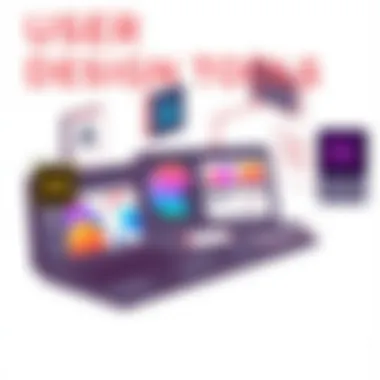
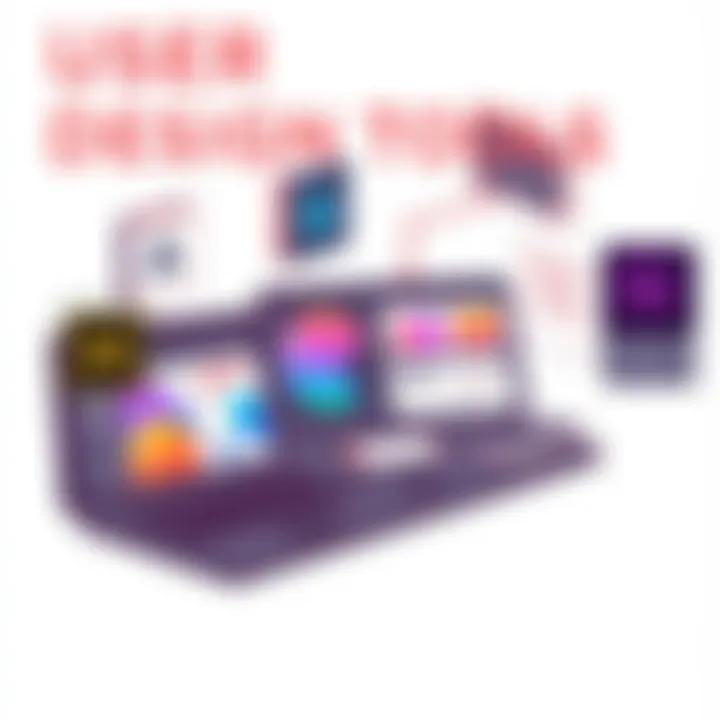
App Overview
When it comes to graphic design, Adobe stands out as a colossal figure in the industry. Yet, many aspiring designers might feel intimidated by the costs associated with Adobe’s full suite of software. Fortunately, several free Adobe graphic design tools are available that don’t skimp on quality and deliver robust features. This section introduces these applications, highlighting their main attributes while ensuring that both novices and seasoned creators can benefit.
Key Features of Free Adobe Apps
The free software offered by Adobe often mirrors the capabilities of their premium counterparts. For instance, Adobe Spark provides users with intuitive options for creating graphics that pop with creativity. Users can access a library of templates and design assets, allowing them to tailor their projects easily without starting from scratch.
Another noteworthy app is Adobe XD, focusing on user experience (UX) and user interface (UI) design. Even in its free version, Adobe XD boasts features like collaboration tools that enable real-time work with teammates. This highlights how Adobe recognizes the need for efficient workflows and communication among designers.
Unique Benefits
Utilizing free Adobe graphic design software offers several advantages:
- Accessibility: It lowers the entry barrier for beginners interested in design.
- Quality: Adobe’s reputation for high-quality tools ensures that you are using reliable software.
- Community Support: With a vast user base, finding tutorials and forums dedicated to Adobe products is easy.
In the following sections, we will delve deeper into each piece of software available for free, discussing their functionalities and providing a comprehensive guide on how you can start your design journey without breaking the bank.
Step-by-Step Walkthrough
To help you get started with Adobe's free tools, let’s outline some basic steps for using Adobe Spark, which is popular among beginners for its ease of use.
- Create an Adobe Account
- Select the Type of Project
- Choose a Template
- Customize Your Design
- Download or Share
- Visit Adobe’s website to sign up for a free account. Make sure to use a valid email.
- Upon logging in, choose whether you want to create a social media post, webpage, or video. Each option leads you to a different interface tailored for that purpose.
- Browse through a gallery of pre-designed templates. This is where you can let your creativity flow without needing extensive design knowledge.
- Use the drag-and-drop interface to add images, text, and other elements. Experiment with different fonts and colors to see what resonates best with your vision.
- Once you’re satisfied, download your graphic or share it directly on social media. Adobe Spark even lets you publish to multiple platforms with just a few clicks.
In each of these steps, you’ll find that the user interface is designed for simplicity, making it accessible whether you’re an app developer looking to create wireframes or a beginner eager to learn.
"Using free software from Adobe can be a stepping stone into the world of graphic design — it provides you the tools to explore without the weight of financial constraints."
Tips and Tricks
Maximizing the potential of Adobe Spark involves knowing some neat tricks:
- Shortcuts: Familiarize yourself with keyboard shortcuts, like to undo your last action or and for copying and pasting elements.
- Use Layers: Group similar items together to make editing easier. This helps streamline your process, especially when dealing with multiple elements.
- Explore Assets: Take advantage of the free stock images and icons provided by Adobe. These can significantly enhance your project’s visual appeal without extra cost.
Common Issues and Troubleshooting
Users may encounter some common bumps along the way while using Adobe tools. Here’s how to tackle them:
- Login Issues: If you have trouble accessing your account, resetting your password can usually fix that. Double-check your internet connection as well.
- Missing Features: Sometimes, users might realize that certain functionalities are locked behind a paywall. Be aware of what’s included for free.
- Export Problems: Should you face difficulties when downloading your projects, checking your browser settings may resolve the issue.
App Comparison
While Adobe Spark offers a lot, it’s essential to contrast it with other free graphic design tools, like Canva and Vectr. Here are some points to consider:
- User Interface: Adobe Spark is noted for its intuitive interface, while Canva provides a slightly broader range of templates.
- Collaboration: Adobe XD takes the cake with live collaboration features, ideal for teams working on UX/UI.
- Design Depth: Vectr, while free, is primarily for vector designs — it doesn’t have the multimedia options found in Adobe products like Spark.
In closing, navigating the world of free Adobe graphic design software is made smoother with this guide. Engaging with these tools not only enhances your design skills but also opens doors for creative expression at no financial cost. Dive in and start creating today!
Understanding Adobe's Graphic Design Software
Adobe has been a dominant player in the graphic design landscape for decades. Its suite of tools not only caters to seasoned professionals but also to novices eager to dip their toes into the world of design. By understanding Adobe’s offerings, users can better navigate the challenges of graphic design, which often involve selecting the right tool for specific tasks. The ability to harness these tools effectively can elevate one's creative potential and streamline workflows.
Overview of Adobe's Offerings
Adobe provides a plethora of graphic design software products, each uniquely tailored to various aspects of the design process. The cornerstone products include Adobe Photoshop, Adobe Illustrator, and Adobe InDesign, to name a few. Here’s a closer look:
- Adobe Photoshop: Ideal for raster graphics and photo editing, Photoshop offers a robust environment for creating and editing images, which can then be used in marketing materials, websites, or social media posts.
- Adobe Illustrator: This tool stands out for its vector graphics capabilities. It allows users to design logos, icons, and intricate illustrations that can be scaled to any size without loss of quality.
- Adobe InDesign: Primarily utilized for layout design, InDesign excels in creating print and digital publications, making it indispensable for designing brochures, magazines, and interactive PDFs.
- Adobe XD: Focused on web and mobile app design, XD enables users to prototype and collaborate on designs swiftly, streamlining the user experience process.
Understanding these tools provides a solid foundation for any designer and can significantly impact the quality of their work. With their various attributes and target user bases, selecting the right software often dictates project outcomes.
Importance of Graphic Design Software
The realm of graphic design is not just about making something visually appealing; it's about communicating ideas effectively. In today's world, where visual content reigns supreme, graphic design software is critical for several reasons:
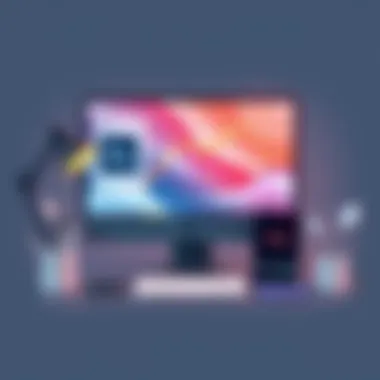
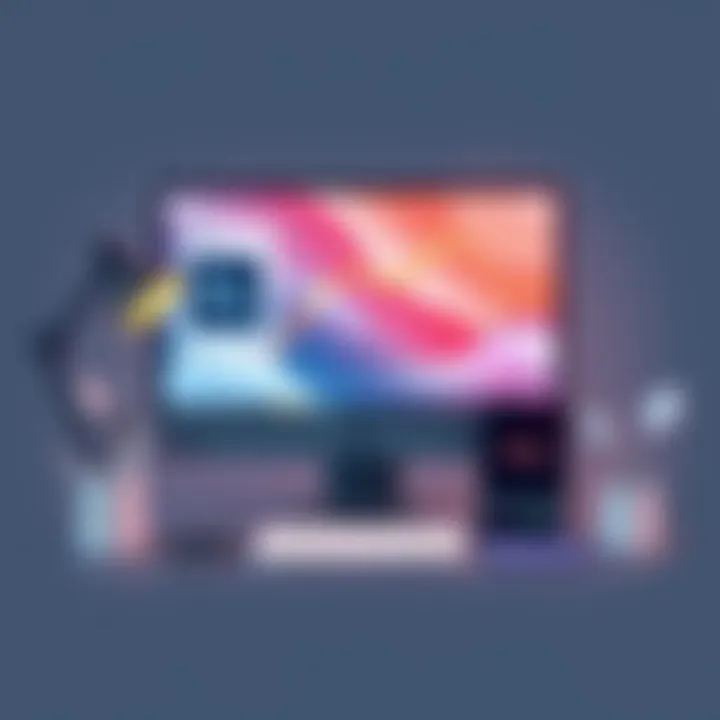
- Enhanced Creativity: Graphic design software empowers users to unleash their creative potential. It offers tools and features that allow for intricate designs that would be hard to achieve manually.
- Increased Efficiency: With intuitive interfaces and powerful functionalities, these tools help designers streamline their workflows. Repetitive tasks can be automated or simplified, freeing up time for more creative endeavors.
- Collaborative Opportunities: Many Adobe tools offer cloud features, allowing several users to work on the same project simultaneously. This interactivity can lead to richer, more diverse design outcomes.
- Accessibility: Free graphic design tools from Adobe make these powerful resources available to everyone, regardless of budget constraints. This democratization of design has allowed a wider range of individuals to express their ideas and showcase their skills.
"Good design is good business." – Thomas Watson Jr.
For further reading on Adobe's product offerings, you might find useful information on Adobe's Official Site and non-user-centered perspectives on tools and their effectiveness can often be discussed in forums like Reddit.
Ultimately, the landscape of design is ever-evolving, and being well-versed in these tools can open a myriad of doors in both personal and professional contexts.
Identifying Free Adobe Software for Designers
In the ever-evolving digital landscape, finding the right software for graphic design can feel like looking for a needle in a haystack. The importance of identifying free Adobe software for designers goes beyond simply saving a few bucks. For many designers, especially those starting out or even seasoned pros attempting to manage their budgets prudently, free tools can open a doorway to creativity without the financial strain attached to paid versions. It is crucial to understand how these free offerings align with individual design goals and project demands.
Moreover, free software can be an excellent gateway for inexperienced users to hone their skills. As a designer, whether dabbling in graphic creation or rewriting the rules, understanding the scope and capabilities of each tool can make a world of difference. This article lays the groundwork for exploring options within the Adobe ecosystem that not only foster creativity but also cater to various design needs.
List of Free Tools Available
Adobe's suite of free tools is diverse, targeting lots of needs from simple editing to complex design projects. Here’s a closer look:
- Adobe Spark: A web-based tool that simplifies the creation of social graphics, web pages, and short videos. It's user-friendly and perfect for quick projects.
- Adobe XD: This one shines in UX/UI design, enabling designers to create interactive prototypes. Its free version offers ample features to get started.
- Adobe Fresco: Tailored for illustrators, Fresco replicates the experience of drawing and painting using a wide array of brushes and tools.
- Adobe Creative Cloud Express: It helps users craft stunning graphics easily, offering templates for various formats that can add flair to any project.
The availability of these tools makes Adobe a valuable resource for both amateurs and veterans in the graphic design field.
Criteria for Free Software Selection
Selecting a free software option involves careful consideration and understanding of personal requirements. Here are some criteria that can guide this selection:
- User Interface and Experience: The tool should have an intuitive, easy-to-navigate interface, making it suitable for users of all skill levels.
- Feature Set: Availability of essential features tailored for the specific type of design work one intends to pursue is paramount. For example, artists may look for extensive brush types in Adobe Fresco, whereas UX/UI designers may prioritize collaboration tools in Adobe XD.
- Compatibility and Integration: The software should integrate well with existing tools and platforms that the designer may already be using, ensuring a seamless workflow.
- Community and Support: Well-supported tools, with access to tutorials, forums, and user discussions, can significantly enhance the learning curve and troubleshooting experience.
Understanding these criteria is key to navigating the vast ocean of free Adobe graphic design software and making informed decisions that align with your goals.
Choosing the right software is crucial as it can significantly impact creativity and efficiency. Focusing on these aspects will help ensure that any free tool picked can help maximize design potential.
In-Depth Look at Adobe Spark
Adobe Spark is often the unsung hero in the Adobe ecosystem, offering a streamlined way for all levels of users to create visually stunning content. This section will explore its significance within the context of graphic design software and how it can be leveraged for different purposes.
One of the most appealing attributes of Adobe Spark is its focus on user accessibility. The platform breaks down barriers that often accompany graphic design software, making it not just intuitive but also quick to learn. This quality is particularly important in a world where time is of the essence. Users can jump right in, whip up engaging graphics, and simply share them across various social media platforms without the steep learning curve typical of many design applications.
Key Features of Adobe Spark
Adobe Spark is laden with features that make it stand out:
- User Interface: The design is clean and user-friendly. This simplicity encourages creativity without overwhelming the user. You don’t need to sift through complex menus to find essential tools.
- Templates: A wide range of customizable templates is available. Whether it’s a social media post, a presentation, or a flyer, there’s probably a template that fits the bill, saving you time and energy.
- Stock Images and Icons: Adobe Spark includes a rich library of stock images and icons. Users can seamlessly incorporate high-quality visuals into their projects without sourcing them elsewhere, enhancing the final output significantly.
- Collaboration Features: The ability to collaborate in real-time cannot be understated. Teams can share projects, collect feedback, and make edits on the go. This makes it an excellent choice for group assignments.
- Branding Options: Users can maintain brand consistency by uploading logos and choosing specific colors. This option is crucial for businesses looking to uphold their brand's identity across different mediums.
By integrating these versatile features, Adobe Spark not only caters to seasoned professionals but also makes graphic design approachable for newcomers.
Who Can Benefit from Adobe Spark?
Adobe Spark is not solely designed for seasoned designers; it caters to a diverse audience:
- Small Business Owners: They can create marketing materials without the need for hiring a designer. This means reduced costs while still achieving effective brand representation.
- Content Creators and Bloggers: Those who need eye-catching visuals can use Spark to produce professional-looking graphics effortlessly. This is especially crucial in the digital age when the visual appeal is a significant driver of engagement.
- Students: Learners can use Adobe Spark for presentations, projects, and assignments. The tool allows students to showcase their work creatively and effectively, which can be a significant advantage in academic settings.
- Social Media Managers: Keeping up with content demands can be a daunting task. Adobe Spark simplifies the process of creating consistent and appealing posts. Its quick share options make it a go-to tool for anyone needing to maintain an active online presence.
"Adobe Spark transforms the design process, making it more accessible to those who might feel daunted by traditional graphic design software."
The benefits gleaned from Adobe Spark are not merely technical; they extend to the time, resources, and creativity that can be invested into projects across various fields. As we gather momentum in our exploration of free Adobe graphic design software, the importance of Adobe Spark cannot be overstated.
Exploring Adobe for Beginners
Adobe XD has become a vital tool for designers venturing into user experience and interface design. With its intuitive design and a plethora of functionalities, it's no surprise that both novices and seasoned professionals flock to this software. In this section, we'll delve into the features and use cases of Adobe XD, breaking down the essentials that can help one navigate this powerful graphic design software effectively.
Functionalities of Adobe
Adobe XD stands tall as a prototype and design powerhouse, catering to the needs of those involved in crafting websites or mobile applications. Key features include:
- Artboards: One can create multiple artboards to visualize different screens or design iterations. This allows for seamless navigation through various design stages.
- Responsive Resize: This functionality enables designers to adapt their creations to different screen sizes effortlessly. It's almost like having a flexible canvas that morphs with your ideas.
- Repeat Grid: This feature streamlines the process of creating repetitive elements in a design, saving time when working on layouts that require similar components, like lists or galleries.
- Interactive Prototyping: Users can turn static designs into interactive prototypes with links, transitions, and animations. This is crucial for testing and gathering feedback—an essential step in a designer’s workflow.
- Collaboration Tools: Integrated features enable real-time sharing and feedback, allowing teams to work together effectively, regardless of their physical locations.
These functionalities combine to form a tool that not only enhances productivity but also fosters creativity in ways that are more engaging than ever before.
Use Cases for Adobe
Adobe XD has carved out a niche in various sectors. Its versatility makes it suitable for a range of projects, including but not limited to:
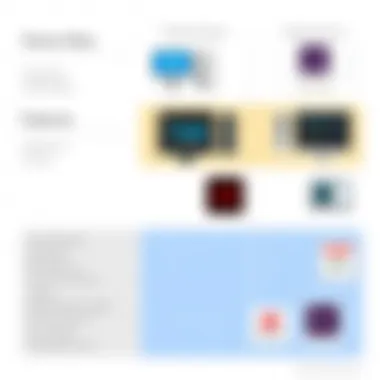
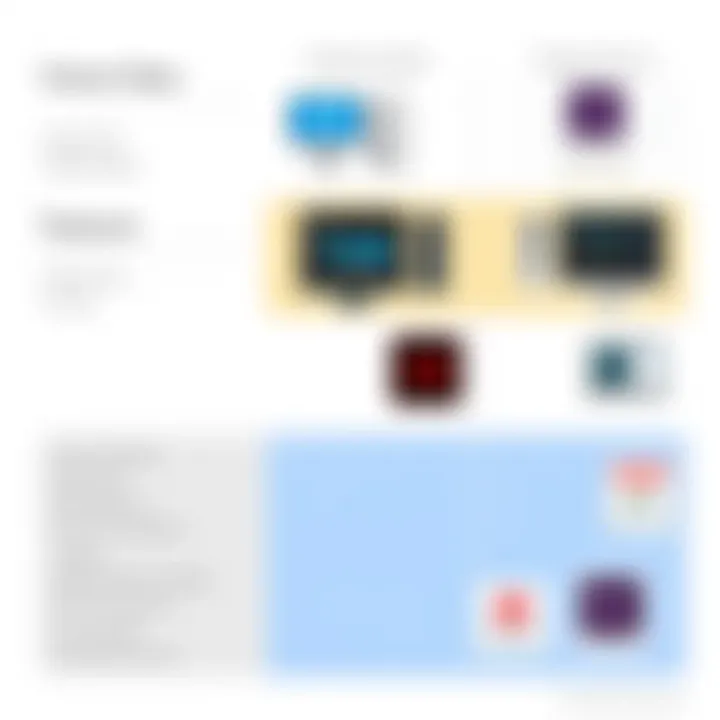
- UI/UX Design: Designers focus on creating user interfaces that are not only visually appealing but also user-friendly. XD allows for the integration of user feedback all through the design process.
- Mobile App Prototyping: For app developers, XD provides an environment to visualize the user journey across applications. Its prototyping capabilities encompass all shapes of interactions, allowing for a thorough exploration of design ideas.
- Web Design: Designers can create responsive web layouts, ensuring a consistent experience across devices. The drag-and-drop functionality makes this process borderline intuitive, which is appealing for beginners who may feel overwhelmed by more complex tools.
- Marketing Projects: Whether it be digital campaigns or social media assets, Adobe XD grants the necessary tools to create engaging marketing materials that can be easily adapted for various platforms.
- Product Demonstrations: It’s also beneficial for businesses looking to demonstrate products digitally. Creating a mock-up can facilitate client presentations, illustrating how the finished product will operate in action.
"Adobe XD isn't just a software; it’s a collaborative environment that enables ideas to evolve into tangible designs."
The combination of these use cases with Adobe XD's powerful functionality encapsulates the essence of its appeal: it can cater to a diverse range of projects, tapping into the creative potential of both individuals and teams. When you combine the right tools with earnest design thinking, the results can be nothing short of exceptional.
Utilizing Adobe Fresco for Digital Art
In the realm of digital art, Adobe Fresco emerges as a significant tool, especially for artists seeking a free yet powerful platform. This software allows both budding and seasoned creators to transform their ideas into vibrant works of art with ease. It operates seamlessly on touchscreen devices, making it particularly appealing for those who enjoy drawing directly on a tablet or smartphone. With Fresco, the capability to blend traditional art techniques with digital tools enhances creativity, offering versatile options for various artistic styles.
Artists can leverage the unique features of Adobe Fresco to produce illustrations, graphics, and even animations. Understanding how to navigate this software not only allows for efficient workflow but also opens doors to exploring different styles and techniques that might not have been possible before. Thus, it becomes crucial for anyone interested in digital artistry to familiarize themselves with this software.
Understanding the Features of Adobe Fresco
Adobe Fresco is packed with a range of features tailored specifically for digital artists. These features are particularly beneficial:
- Real-time Brushes: The live brushes mimic traditional media like oil and watercolor, allowing fluid transitions between colors and textures.
- Vector and Raster Support: Artists can choose between vector artwork for scalability or raster for detailed imagery.
- Layering System: Fresco’s robust layering capabilities let users manage different components easily, akin to Adobe Photoshop but simpler and more intuitive.
- Cloud Integration: Seamless integration with the Adobe Cloud means artists can sync their work across devices, ensuring flexibility wherever inspiration strikes.
Furthermore, the user-friendly interface aids in reducing the learning curve for beginners. Fresco's canvas can be customized to various sizes, accommodating the needs of different projects and preferences. Overall, the functionalities available in Adobe Fresco make it an invaluable asset to any digital artist's toolkit.
Adobe Fresco vs Other Drawing Tools
When weighing Adobe Fresco against other drawing tools, several factors come into play that highlight its distinct advantages.
- User-Friendliness: Compared to complex programs like Corel Painter, Fresco's interface is simpler and more intuitive. This makes it easier for novices to dive right in without feeling overwhelmed.
- Integration with Adobe Suite: Unlike Sketchbook or Procreate, Fresco seamlessly integrates with other Adobe products, which allows for a more unified workflow for users invested in the Adobe ecosystem. This cross-compatibility especially shines when combining Fresco with Photoshop or Illustrator for enhanced effects.
- Cost-Effectiveness: Adobe Fresco is freely available, which stands in contrast to many competitors that require hefty one-time purchases or subscriptions. This makes high-quality digital drawing tools accessible to everyone, from hobbyists to professional artists.
"Adobe Fresco’s capabilities represent the evolution of digital artistry, allowing creators to explore without financial constraints."
Despite these advantages, it is essential to recognize areas where Fresco might lag behind. Certain advanced features found in software like Clip Studio Paint may not be present in Fresco, limiting more specialized workflows. However, for traditional artists transitioning to digital art, Adobe Fresco appears to be a solid choice, bridging the gap and providing a rich suite of essential tools without the usual sticker shock.
In summary, Adobe Fresco stands out as a major player in the digital art landscape. Its thoughtful design and functionality cater to fluctuating skill levels, allowing for greater versatility in expression. As designers explore various artistic avenues, Fresco serves as an excellent starting point and a powerful companion in their creative journey.
Harnessing Adobe Creative Cloud Express
Understanding how to effectively utilize Adobe Creative Cloud Express can unlock a world of design possibilities, particularly for individuals who want to create visually appealing content without the steep learning curve often associated with traditional graphic design software. This tool serves as an accessible entry point for beginners while still providing enough depth for seasoned designers. The importance of harnessing Adobe Creative Cloud Express lies in its capability to streamline workflows, foster creativity, and offer an assortment of design assets.
Features of Creative Cloud Express
Adobe Creative Cloud Express comes packed with an array of features designed to cater to a wide audience, from novices to seasoned pros. Here are some standout elements:
- Intuitive Interface: The layout is user-friendly, offering drag-and-drop functionality that quickly gets users on the design bandwagon.
- Template Library: There's a treasure trove of ready-made templates that range across various formats—from social media posts to flyers. This can jumpstart the creative process.
- Integration with Other Adobe Tools: Users can seamlessly incorporate assets created in other Adobe applications, creating a more cohesive workflow.
- Collaborative Features: Sharing designs and working collaboratively is easy, as the platform allows multiple users to edit and provide feedback.
Typically, the best design work comes when tools are easy to navigate. With Creative Cloud Express's drag-and-drop approach and pre-built templates, users spend less time wrestling with software and more time focused on creativity.
Best Practices with Creative Cloud Express
To truly harness the potential of Adobe Creative Cloud Express, here are some best practices that can elevate your design game:
- Start with Templates: When in doubt, grab a template that suits your project. Don’t be afraid to experiment with different layouts.
- Leverage Design Assets: Take advantage of stock photos, icons, and illustrations available within the platform. These assets can add a professional touch to your work.
- Maintain Consistency: Use similar color schemes and fonts throughout your designs to ensure a cohesive look. This helps build brand identity if you're working on marketing materials.
- Utilize Tutorials: Make the most of the numerous tutorials available both on Adobe’s website and platforms like YouTube. The learning never stops!
- Feedback Loop: Share your designs with peers and ask for feedback. Multiple eyes on a project can illuminate perspectives you might not have considered.
Following these practices can not only improve design quality but also enhance the overall efficiency of utilizing Creative Cloud Express for your projects. Harnessing the versatility of this tool can take your creative efforts far and wide.
Evaluating Limitations of Free Adobe Software
In any exploration of tools, understanding their limitations is just as crucial as knowing their strengths. When it comes to free Adobe graphic design software, these tools undoubtedly provide a great entry point for both novice designers and seasoned enthusiasts. However, beneath the surface charm of zero-cost applications lie some hurdles. Evaluating these limitations helps users navigate wisely, setting the right expectations for what they can achieve without spending a dime.
For instance, while free software can open doors to creativity, they often come with certain restrictions that can be frustrating. Features might be limited or scaled-down versions of what paid users enjoy, which can directly clash with creative ambitions. Assessing these limits can help users avoid any unwelcome surprises down the line, ensuring they choose the right tool for their particular project needs.
Common Restrictions Encountered
Many users bump into a few familiar hurdles when using free Adobe applications. Understanding these bumps on the road can save time and energy. Here are some of the most common restrictions:
- Limited Functionality: Free versions may not include advanced features, leaving some users feeling like they are only scratching the surface. For example, Adobe Spark offers great templates, but you won’t find every fancy feature that Adobe Illustrator provides.
- Watermarked Outputs: Some tools may impose watermarks on finished projects. This situation can be a deal-breaker, especially for professionals needing clean deliverables for clients.
- Cloud Storage Limits: Free versions often come with restricted cloud storage, meaning users might need to delete older projects to make room for new ones. This can be an additional hassle, particularly for those working on multiple designs.
- Incompatibility with Other Tools: Certain free software may not integrate smoothly with other applications which can make workflows cumbersome. For instance, saving a project from Adobe Fresco to upload directly to Adobe XD might not be as seamless as it is between fully paid versions of those tools.
- Customer Support Deficiency: Users of free versions usually have less access to customer support. This means if you get stuck, you might have to rely on online guides or community forums, leading to potentially longer resolution times.
Comparing Free vs Paid Software
When weighing free Adobe software against their paid counterparts, one cannot ignore the extensive chasm that exists between the two. Let's break it down:
- Features Galore: Paid software often comes packed with advanced features such as enhanced vector tools, comprehensive asset libraries, and robust collaboration capabilities that are typically absent in free versions. For example, Adobe Illustrator includes extensive drawing and type tools which aren’t found in Spark.
- Quality Control: Paid applications generally offer smoother performance and few bugs or glitches, enhancing the overall user experience. The stability alone can make it worth the investment.
- Professional Outputs: A key differentiator for many users is the output quality. While free options might suffice for personal projects or learning purposes, they may falter when it comes to the professional finish needed in a business environment.
- Access to Updates: Paid versions tend to receive regular updates, security patches, and new features much more consistently. Free alternatives might lag behind, which can leave users with outdated tools and capabilities.
- Community and Resources: Paid platforms often come with an extensive community and a wealth of tutorials, allowing users to refine their skills faster. Free software, while useful, often lacks such infrastructure.
Overall, the choice between free and paid software hinges on a user's goals, needs, and budget. By being acutely aware of limitations, designers can make informed decisions, aligning their expectations with the tools at hand.


"Limitation is the mother of creativity." - This resonates particularly well in the context of free graphic design software, where creativity must thrive despite certain constraints.
For further insights into graphic design tool options and comparisons, you might check out resources like Adobe's official site or engaging discussions on Reddit.
Alternatives to Consider for Graphic Design
In the realm of graphic design, relying solely on Adobe software can be a double-edged sword. While Adobe provides superb functionalities, exploring non-Adobe tools opens a treasure trove of opportunities. This section shines a spotlight on why it's essential to consider alternatives, especially for newcomers to the domain or those on a budget. More options mean varied features, sometimes more tailored to specific needs. A multi-tool approach can often serve designers better, catering to diverse projects and styles.
Overview of Non-Adobe Tools
When digging into the vast landscape of graphic design tools, numerous options lie beyond the well-trodden path of Adobe. Here are some noteworthy alternatives to keep an eye on:
- Canva: Known for its user-friendly interface, Canva simplifies design for everyone, from students to marketing experts. With a myriad of templates and an extensive library of images, it's ideal for quick projects.
- GIMP: This open-source image editor packs a punch. GIMP offers functionalities similar to Photoshop without any cost. While its interface may not be as polished, the capabilities are impressive for those willing to invest time in learning.
- Inkscape: A favorite among vector graphic enthusiasts, Inkscape allows for precise control over paths and shapes. It’s particularly beneficial for logo design and illustration.
- Krita: Aimed at digital artists, Krita excels in painting and concept art. With brushes that mimic traditional techniques, it attracts those wanting to bring a personal touch to their creations.
- Figma: Primarily used for UI/UX design, Figma’s collaborative features make it a standout choice. It allows teams to work together seamlessly in real-time, a feature increasingly relevant in today’s remote-working environment.
Each of these tools comes with its own set of strengths and weaknesses, but they all contribute to a well-rounded toolkit that ensures designers can adapt to their project's specific demands.
How Adobe Compares with Alternatives
When weighing Adobe against its counterparts, various factors come into play. Here are key comparisons:
- Pricing: Free tools like GIMP or Canva provide budget-friendly solutions, while Adobe's Creative Cloud suite can quickly add up. For individuals or small startups, this price difference can be substantial.
- User Experience: Many alternative tools are geared towards simplicity. For instance, Canva’s drag-and-drop functionality is a breath of fresh air compared to Adobe's more complex interfaces. New users might find it less daunting to dive into design using simpler programs.
- Specific Features: Adobe applications excel in advanced features, particularly in photo editing and vector graphics. However, some alternatives, like Figma, provide unique advantages in collaboration and prototyping, which Adobe's offerings may not prioritize as effectively.
- Community and Support: Adobe has a vast community with resources, but non-Adobe tools often have passionate user bases as well. Platforms like Reddit have dedicated forums where users share insights, best practices, and troubleshoot common issues.
"While Adobe remains a cornerstone in professional graphic design, exploring alternatives could enhance creativity and efficiency."
Community and Support Resources
In the vast realm of graphic design, particularly when it comes to leveraging free Adobe software, having access to robust community and support resources cannot be overstated. The design journey can oftentimes feel like traversing an uncharted landscape. Here, community and support act as guiding beacons, providing invaluable insights and assistance. These resources help users to not only enhance their skills but also to connect with others who share their passion for design.
Utilizing community platforms enables designers—both novices and seasoned professionals—to share knowledge, troubleshoot issues, and seek advice from peers who have faced similar challenges. Furthermore, the dedication to community support reflects a shared commitment to education and growth within the discipline.
Accessing Adobe Community Forums
Adobe has cultivated a rich tapestry of forums where users from all walks of life can congregate and discuss issues regarding their favorite tools. These Adobe Community Forums serve as melting pots of ideas, solutions, and camaraderie. Users can pose questions, contribute answers, and even browse archived discussions that tackle everything from basic functionalities to advanced design techniques.
Benefits of using these forums include:
- Real-time responses: Engage with experienced users who often respond quickly to queries.
- Diverse perspectives: Gain insights from users across the globe, enriching your understanding of various design styles and approaches.
- Networking opportunities: Connect with other designers which can lead to collaborations, mentorship, or job opportunities.
For those just stepping into the world of graphic design, taking the initiative to explore these forums can be akin to finding a mentor. The beginner’s hesitation often dissipates when they realize there’s a wealth of support waiting just a few clicks away.
Finding Tutorials and Guides
Navigating graphic design tools can be daunting without proper guidance. Fortunately, the Adobe ecosystem is littered with comprehensive tutorials and guides designed to help users master its free software. Whether through written articles, videos, or interactive courses, the information is often just a search away.
In searching for tutorials, consider focusing on your specific needs, whether that’s a step-by-step guide on using Adobe Spark for social media graphics or exploring the functionalities of Adobe XD for prototyping. Here’s how to make the most of available resources:
- YouTube Channels: Many creators share in-depth tutorials that cover basic to advanced techniques. Channels dedicated to graphic design often feature playlists specific to Adobe tools.
- Adobe Help Center: This official repository has a trove of tutorials, tips, and user guides. It’s worth bookmarking.
- Community Blogs: Various community-driven websites host blog entries penned by users detailing their experiences and project walkthroughs.
By tapping into these resources, graphic designers can elevate their work significantly.
"The right guidance at the right time can turn confusion into clarity and possibilities into reality."
In summary, community and support resources are integral for anyone delving into the free Adobe graphic design software pool. They provide not just technical assistance but also a sense of belonging in the ever-evolving design community.
Future of Free Graphic Design Tools
In the swiftly evolving world of graphic design, understanding the trajectory of free tools becomes crucial for both budding artists and seasoned professionals. The availability of free graphic design software has transformed the landscape, empowering individuals from diverse backgrounds to tap into their creative potential without hefty financial commitments. This section explores significant elements that highlight the relevance of free graphic design tools and their anticipated developments.
The importance of free graphic design tools lies primarily in their accessibility. They allow aspiring designers to experiment with ideas at minimal risk, thus nurturing creativity without the burden of subscription fees. This democratization of technology shifts the paradigm, giving people from various economic backgrounds the opportunity to pursue careers in creative fields. Moreover, businesses also benefit as they can leverage these tools for their branding and marketing efforts without stretching their budgets.
Trends in Graphic Design Software
As we look at the trends shaping free graphic design software, a few key elements stand out:
- Increased Integration with AI: Free tools are increasingly incorporating artificial intelligence capabilities, enabling users to automate certain design processes or gain suggestions based on their work. This not only speeds up workflow but also helps in producing high-quality outputs with minimal effort.
- User-Centric Design: The focus on user experience continues to grow. Many free Adobe tools have been designed to be intuitive and easy to use, making them suitable for beginners who may not have extensive backgrounds in design. This trend shows that software is moving towards enhancing user engagement and retention by simplifying interfaces and workflows.
- Community-Based Resource Sharing: Platforms like Reddit and various forums are fostering communities where users can share resources, tips, and inspiration. This communal aspect enriches the learning experience, offering valuable insights that might not be found in traditional educational setups.
These trends suggest a future where graphic design tools are not just software, but comprehensive ecosystems enabling collaboration, creativity, and efficiency.
"The future isn’t a place we’re going, it’s a place we’re creating."
— John Sweeney
What to Expect from Adobe Moving Forward
Looking ahead, Adobe appears set to strengthen its commitment to providing versatile free tools alongside its traditional offerings. Here are some expectations:
- Enhanced Features for Free Tools: Adobe is likely to continue rolling out updates and additional functionalities to their existing free applications, ensuring that designers can access cutting-edge tools without the financial burden. This might include advanced assets, new templates, or integration with other Adobe products.
- Expanded Educational Resources: We can anticipate Adobe to amplify its efforts in providing tutorials and learning resources aimed at beginners. By doing so, they not only prepare users to make full use of the tools available but also foster a new generation of designers who might become loyal customers in the future.
- Focus on Collaboration and Remote Work: With the rise of remote working environments, it’s feasible to expect Adobe to enhance collaboration features in their free software offerings. Tools that facilitate teamwork on design projects will be invaluable in today’s digital workspace.
Overall, the future of free graphic design tools, especially within Adobe’s realm, looks promising. The combination of innovative features along with a strong educational support system will likely cultivate an even more vibrant creative community.







